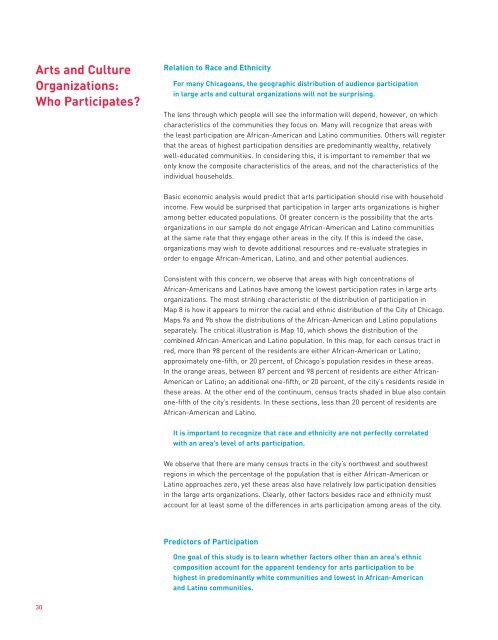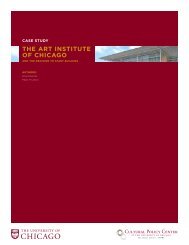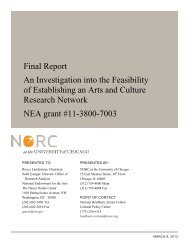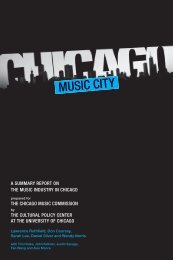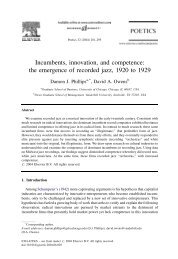Mapping Cultural Participation in Chicago - Cultural Policy Center
Mapping Cultural Participation in Chicago - Cultural Policy Center
Mapping Cultural Participation in Chicago - Cultural Policy Center
Create successful ePaper yourself
Turn your PDF publications into a flip-book with our unique Google optimized e-Paper software.
Arts and CultureOrganizations:Who Participates?Relation to Race and EthnicityFor many <strong>Chicago</strong>ans, the geographic distribution of audience participation<strong>in</strong> large arts and cultural organizations will not be surpris<strong>in</strong>g.The lens through which people will see the <strong>in</strong>formation will depend, however, on whichcharacteristics of the communities they focus on. Many will recognize that areas withthe least participation are African-American and Lat<strong>in</strong>o communities. Others will registerthat the areas of highest participation densities are predom<strong>in</strong>antly wealthy, relativelywell-educated communities. In consider<strong>in</strong>g this, it is important to remember that weonly know the composite characteristics of the areas, and not the characteristics of the<strong>in</strong>dividual households.Basic economic analysis would predict that arts participation should rise with household<strong>in</strong>come. Few would be surprised that participation <strong>in</strong> larger arts organizations is higheramong better educated populations. Of greater concern is the possibility that the artsorganizations <strong>in</strong> our sample do not engage African-American and Lat<strong>in</strong>o communitiesat the same rate that they engage other areas <strong>in</strong> the city. If this is <strong>in</strong>deed the case,organizations may wish to devote additional resources and re-evaluate strategies <strong>in</strong>order to engage African-American, Lat<strong>in</strong>o, and and other potential audiences.Consistent with this concern, we observe that areas with high concentrations ofAfrican-Americans and Lat<strong>in</strong>os have among the lowest participation rates <strong>in</strong> large artsorganizations. The most strik<strong>in</strong>g characteristic of the distribution of participation <strong>in</strong>Map 8 is how it appears to mirror the racial and ethnic distribution of the City of <strong>Chicago</strong>.Maps 9a and 9b show the distributions of the African-American and Lat<strong>in</strong>o populationsseparately. The critical illustration is Map 10, which shows the distribution of thecomb<strong>in</strong>ed African-American and Lat<strong>in</strong>o population. In this map, for each census tract <strong>in</strong>red, more than 98 percent of the residents are either African-American or Lat<strong>in</strong>o;approximately one-fifth, or 20 percent, of <strong>Chicago</strong>’s population resides <strong>in</strong> these areas.In the orange areas, between 87 percent and 98 percent of residents are either African-American or Lat<strong>in</strong>o; an additional one-fifth, or 20 percent, of the city’s residents reside <strong>in</strong>these areas. At the other end of the cont<strong>in</strong>uum, census tracts shaded <strong>in</strong> blue also conta<strong>in</strong>one-fifth of the city’s residents. In these sections, less than 20 percent of residents areAfrican-American and Lat<strong>in</strong>o.It is important to recognize that race and ethnicity are not perfectly correlatedwith an area’s level of arts participation.We observe that there are many census tracts <strong>in</strong> the city’s northwest and southwestregions <strong>in</strong> which the percentage of the population that is either African-American orLat<strong>in</strong>o approaches zero, yet these areas also have relatively low participation densities<strong>in</strong> the large arts organizations. Clearly, other factors besides race and ethnicity mustaccount for at least some of the differences <strong>in</strong> arts participation among areas of the city.Predictors of <strong>Participation</strong>One goal of this study is to learn whether factors other than an area’s ethniccomposition account for the apparent tendency for arts participation to behighest <strong>in</strong> predom<strong>in</strong>antly white communities and lowest <strong>in</strong> African-Americanand Lat<strong>in</strong>o communities.30


